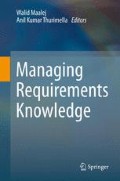Abstract
Writing a good software requirement specification is a complex task. Many different aspects must be taken into account; most of them can only be learned through experience. Being aware of experiences and distilled best practices at the right time when writing a specification is another challenge. Experience-based requirements engineering tools make sharing and reuse of experience feasible. In this chapter, we present design principles for such tools, define a learning model to describe how organisations and individuals can learn new experiences by using them, and sketch a strategy for evaluating experience-based requirements engineering tools. We highlight these concepts with an example.
Access this chapter
Tax calculation will be finalised at checkout
Purchases are for personal use only
Notes
References
Schneider K (2009) Experience and knowledge management in software engineering. Springer, Berlin
Senge PM (1993) The fifth discipline: the art and practice of the learning organization. Century Business Random House, London
Kiyavitskaya N, Zeni N, Mich L, Berry DM (2008) Requirements for tools for ambiguity identification and measurement in natural language requirements specifications. Requir Eng 13:207–239
Schön DA (1983) The reflective practitioner: how professionals think in action. Basic Books, New York
Fischer G (1994) Domain-oriented design environments. Autom Sof Eng 1:177–203
Knauss E, Lübke D, Meyer S (2009) Feedback-driven requirements engineering: the heuristic requirements assistant. In: Proceedings of the IEEE 31st international conference on software engineering, IEEE, Vancouver, Canada, pp 587–590
Cockburn A (2001) Writing effective use cases. Addison-Wesley, Boston
Kusumoto S, Matukawa F, Inoue K, Hanabusa S, Maegawa Y (2004) Estimating effort by use case points: method, tool and case study. In: Proceedings of the 10th international symposium on software metrics, IEEE, Chicago, USA, pp 292–299
Maciaszek LA (2007) Requirements analysis and system design. Pearson Education Limited, Harlow
Berry DM, Kamsties E, Krieger MM (2003) From contract drafting to software specification: linguistic sources of ambiguity, Technical report, University of Waterloo
Luhn HP (1958) The automatic creation of literature abstracts. IBM J Res Develop 2:159–165
Willett P (2006) The Porter stemming algorithm: then and now. Program Electron Lib Inform Syst 40:219–223
Knauss E, Houmb S, Schneider K, Islam S, Jürjens J (2011) Supporting requirements engineers in recognising security issues. In: 17th international working conference on requirements engineering: foundation for software quality, Essen, Germany, pp 4–18
Berry DM, Kamsties E (2003) Ambiguity in requirements specification. In: do Leite Prado JCS, Doorn JH (eds) Perspectives of requirements engineering. Kluwer, Norwell, pp 7–44
Wilson WM, Rosenberg LH, Hyatt LE (1997) Automated analysis of requirement specifications. In: Proceedings of the 19th international conference on software engineering (ICSE’97. ACM, New York, pp 161–171
Kof L (2005) Text analysis for requirements engineering. Ph.D. thesis, Technische Universität München, Germany
Lee SW, Muthurajan D, Gandhi RA, Yavagal DS, Ahn G-J (2006) Building decision support problem domain ontology from natural language requirements for software assurance. Int J Softw Eng Knowl Eng 16:851–884
Chantree F, Nuseibeh B, de Roeck A, Willis A (2006) Identifying nocuous ambiguities in natural language requirements. In: Proceedings of the 14th IEEE international requirements engineering conference. IEEE Computer Society, Minneapolis, pp 56–65
Gleich B, Creighton O, Kof L (2010) Ambiguity detection: towards a tool explaining ambiguity sources. In: Wieringa R, Persson A (eds) Proceedings of requirements engineering: foundation for software quality (REFSQ). Springer, Essen, pp 218–232
Fabbrini F, Fusani M, Gnesi S, Lami G (2001) An automatic quality evaluation for natural language requirements. In: Proceedings of the seventh international workshop on RE: foundation for software quality (REFSQ 2001), Interlaken, pp 150–164
Fantechi A, Gnesi S, Lami G, Maccari A (2002) Application of linguistic techniques for use case analysis. In: Proceedings of IEEE joint international conference on requirements engineering, Essen, pp 157–164
Melchisedech R (2000) Verwaltung und Prüfung natürlichsprachlicher Spezifikationen. Ph.D. thesis, Fakultät Informatik, Universität and Stuttgart, Germany
Somé SS (2006) Supporting use case based requirements engineering. Inform Softw Technol 48:43–58
Jang H-C (1994) A knowledge-based analyzer for requirements specification analysis. In: Proceedings of the sixth international conference on tools with artificial intelligence, New Orleans, USA, pp 276–282
Hunter A, Nuseibeh B (1998) Managing inconsistent specifications: reasoning, analysis, and action. ACM Trans Softw Eng Methodol 7:335–367
Gervasi V, Zowghi D (2005) Reasoning about inconsistencies in natural language requirements. ACM Trans Softw Eng Methodol 14:277–330
Berenbach B, Borotto G (2006) Metrics for model driven requirements development. In: ICSE’06: Proceedings of the 28th international conference on software engineering. ACM, Shanghai, pp 445–451
de Souza CRB, Oliveira HLR, da Rocha CRP, Gonçalves KM, Redmiles DF (2003) Using critiquing systems for inconsistency detection in software engineering models. SEKE, San Francisco, USA, pp 196–203
Gervasi V, Zowghi D (2010) On the role of ambiguity in RE. In: Wieringa R, Persson A (eds) Proceedings of requirements engineering: foundation for software quality (REFSQ). Springer, Essen, pp 248–254
Adam S, Doerr J, Eisenbarth M, Gross A (2009) Using task-oriented requirements engineering in different domains – experience of application in research and industry. In: Proceedings of the 17th IEEE international requirements engineering conference (RE’09), Atlanta, pp 267–272
Knauss E, Flohr T (2007) Managing requirement engineering processes by adapted quality gateways and critique-based RE-tools. In: Proceedings of workshop on measuring requirements for project and product success, Palma de Mallorca, Spain
Knauss E, Schneider K (2012) Supporting learning organisations in writing better requirements documents based on heuristic critiques. In: Regnell B, Damian D (eds) Proceedings of requirements engineering: foundation for software quality (REFSQ’12). Springer, Heidelberg/Essen, pp 165–171
Knauss E, Schneider K, Stapel K (2009) Learning to write better requirements through heuristic critiques, IEEE, Atlanta, USA
Author information
Authors and Affiliations
Corresponding author
Editor information
Editors and Affiliations
Rights and permissions
Copyright information
© 2013 Springer-Verlag Berlin Heidelberg
About this chapter
Cite this chapter
Knauss, E., Meyer, S. (2013). Experience-Based Requirements Engineering Tools. In: Maalej, W., Thurimella, A. (eds) Managing Requirements Knowledge. Springer, Berlin, Heidelberg. https://doi.org/10.1007/978-3-642-34419-0_15
Download citation
DOI: https://doi.org/10.1007/978-3-642-34419-0_15
Published:
Publisher Name: Springer, Berlin, Heidelberg
Print ISBN: 978-3-642-34418-3
Online ISBN: 978-3-642-34419-0
eBook Packages: Computer ScienceComputer Science (R0)

